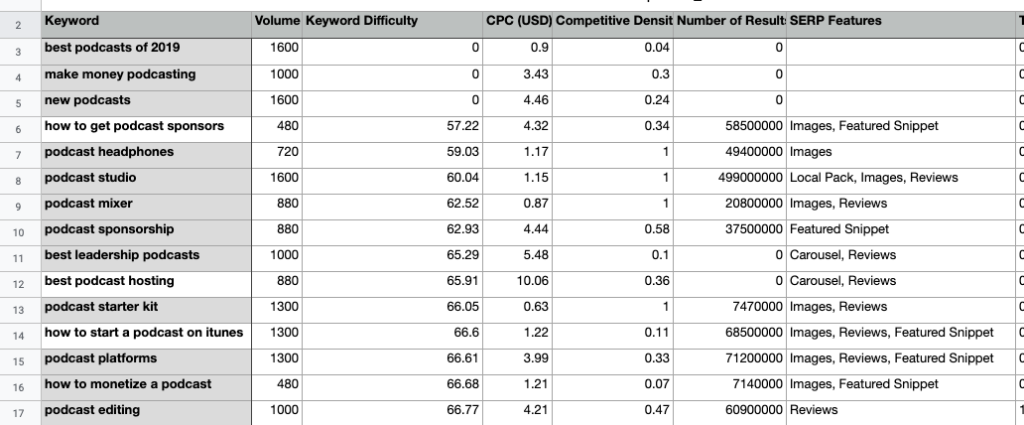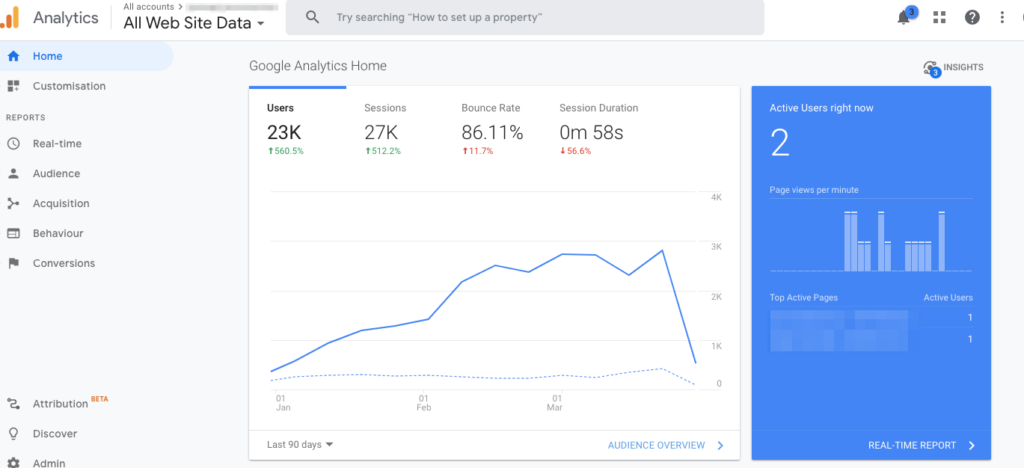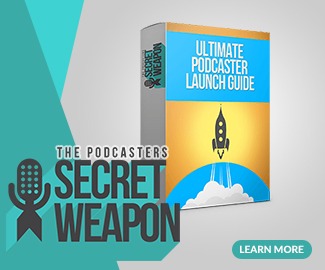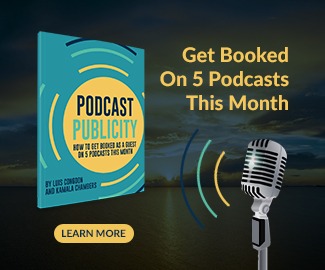If you’re lacking engagement you might consider B2B content marketing.
Not enough visits to your website?
Not enough engagement?
Or not enough conversions and sales coming from your website?
In this article, we’ll give you B2B and B2C content marketing strategies that increase website traffic, click-through rates, conversions, and inbound leads.
B2B & B2C Content Marketing Strategies For 2020
When it comes to content marketing – it’s all the same.
The one key difference for anyone is this:
Who are you writing content for?
Once you have that figured out, the process is always the same.
Even if you’re doing business to business or business to consumer marketing – the strategy to develop and create content is the same. Yes, knowing who you’re writing to determines what you write – but it won’t alter how your research, create or even market your content.
In today’s post, we’re going to look at content marketing strategies that work for B2B and B2C companies. First, we’ll look at how to map out a content marketing strategy. After that, we’ll go into the different approaches that assure your content ranks in Google, gets found, and is the very best in your market.
B2B content marketing is the art of using content to drive brand awareness, generate leads, and increase sales. Some examples of B2B content marketing are blogs, social media content, videos, email outreach, and podcasts.
Why content marketing is important for B2B?
In a world where nearly everyone conducts online research and most everyone needs 6-8 quality touch points before buying a product – content marketing ensures your ideal client find you.
In this post, I’ll lay content marketing strategies to help you:
- Understand why content marketing matters
- Map out the best content marketing strategy
- Find the right content, so your website ranks in Google
- Four barely used strategies that make your content better than anyone else’s.
- How to find the ‘content gaps’ your competitors aren’t using.
- Three highly underutilized methods to generate leads and clicks.
- What we did to grow a teeny-tiny website by 550% with just content (no ads, no social media, no email list)
Here’s how this article is laid out:
Part One: Content Marketing For Your Website
(Ranking your website, generating targeted traffic, gaming the search engines)
Part Two: Optimizing Your Content Marketing For Conversions
(Assure your content converts)
Part Three: How To Leverage Social Media
(Creating omnipresence)
As you read, you’ll find this I’m heavily focused on content marketing through your website. When it comes to B2B content marketing or B2C content marketing – your website is the ticket to making sales.
Why Content Marketing Matters For Your Website
- With a website, you own your presence, branding, and can make sales (social media leaves you at the mercy of the social site)
- Websites allow you a bigger return on investment for email (leading data shows email offers a $4 profit for every $1 spent).
- Once you collect data on your visitors you can retarget them with targeted ads.
- Your website allows you to make direct sales online (social doesn’t).
- Social media posts have a short lifespan (average 24 hrs – 72 hours), but blog posts last for years.
- Blog posts and pages capitalize on SEO and help you get found on all search engines.
- Website traffic can be measured, optimized, and lead to inbound leads.
- Social media is highly weighted for, ‘pay-to-play’
- You can’t sell on social media, but you can with your website.
- Website content allows you to send social media fans, email fans, and customers to targeted pages to help educate and close deals.
- Your sales team can use online content to help close sales faster (but you wouldn’t send prospects to a social media post).
As you can tell, when it comes to capitalizing on content – your website is king.
Even without social media, you can generate leads and make sales – but without a website, it’s impossible to grow an email list and very difficult to sell.
Now that we’ve looked at why your website is your number one content marketing asset – let’s look at how to capitalize with content to increase sales.
Step #1:
Learn Your Client’s “Search Habits”

Let’s assume you already know who your ideal client is.
You know what you have to sell. You know why they want to buy your product.
Given all that data, we still need to figure out:
“What do your ideal clients do when they’re online?”
“What words do they type into Google when there’s a problem?”
“How do they find the solutions you’re offering?”
These are the key questions we need to determine. This isn’t about ‘defining your ideal client.’ This exercise helps you figure out – what do my clients do when they search for solutions.
To get your answers, you’ll need three different tools:
1. Your mind and patience.
2. A desktop with Google on it.
3. Software like SEMrush (not necessary, but it’ll make this much easier). Here’s a link for a 7-day free trial, which is likely all you’ll need. *Grab your trial now so you can follow along below*
Now, it’s time to get started.
Here are the steps you’ll need to take:
- Open up your Google web browser on the desktop (Google needs to be your search engine).
- Start typing things related to your product (pains, problems, common phrases).
- Notice what Google’s autocompleting feature brings up.
- Click and review the different results.
- Take note of what websites come up, common phrases, and other things (more on this later).
- Play with the autocomplete results. If you type one thing and you get an autocomplete, try hitting the spacebar and type in different letters to see what comes up. Poke around and look at the results that come up.
Here’s an ‘over my shoulder’ video walkthrough of how I would do this process:
This exercise reveals useful information regarding your clientele’s ‘search habits’ online. Along with that, here’s another benefit of doing this work: searching the results in Google helps you mine data about your competitors’ strengths, weaknesses, opportunities, and threats online (in business school, we call this a SWOT analysis).
As you’re searching, it’s beneficial to click on the top-ranking website pages.
The point here isn’t so much to study your competition; it’s just a benefit (I’ll get into this later). The real ‘meat’ of this activity is how much data you’ll discover about your clients’ online habits, so you can better market and create content that attracts them to your website.
While you’re looking at pages, start looking at these things:
- How the top-ranking pages give answers to the searches, you found.
- The layout of the pages and blog articles
- Common websites that show up in your searches
- Articles that look popular or that maybe you could mimic on your site.
This will be important when we start digging deeper.
As you can tell, if you’re in B2B or B2C, this step is always going to be the same.
When we are helping a grocery franchise, a senior care company, a nutrition school, chiropractors, or a company with physical products – we use the same process to help them. No matter what industry you’re in, the process is the same.
Once you’ve done this, it’s time to use a ‘fine combing’ tool to help us extract more in-depth data. The information that Google won’t give us can be better understood with an SEO tool like SEMrush. *Below, I’ll teach you how to do deep recon with SEMrush in just 5 minutes*
Step #2
Use A Recon Tool To Extract Key Data

When you’re creating a content marketing plan, expert tools will enhance your work and expedite how fast you rank.
If you’re never used a tool like SEMrush, Ahrefs, or Moz Pro – let me explain why it’ll be helpful to use one these softwares:
1. They help you find data on a website’s rankings.
2. They rank content ideas from easy to difficult so you can choose wisely.
3. They allow you to see what other brands are doing that you’re not.
4. They offer comparisons and analyses of your competitors so you can find the ‘gaps’ and compete in ways your competition doesn’t.
5. They give you insights that Google won’t disclose even if you’re paying.
When I first started, I thought using a tool like SEMrush would take forever and be expensive. Contrary to my belief, I was able to learn this tool quickly and use it to create a 550% organic growth to a teeny-tiny website with just content. Without ads, no social media, no backlinking strategy, and not even an email list, I organically grew my passion-hobby website quickly.
The essential tools to make something like that happen for you is this: SEMrush and Google. These two tools are the key to unlocking organic traffic growth curves.
One Quick Note:
As you learn more about content marketing, you’ll find there are other tools like Ahrefs, Moz Pro, and Ubersuggest (the one I like the least, but it’s completely free). These are all excellent tools; I just happen to prefer SEMrush because of their superb training and top-notch customer support.
I highly recommend you get a free 7-day trial of SEMrush to follow along (or mimic what I do with the free Ubersuggest tool, it’s not as robust but can be a useful tool too).
Quick & Dirty Content Marketing Strategy With SEMrush
As you can see in the video, with SEMrush, I’m able to extract highly valuable information. AS you research, you’ll want to write down keywords that you like and the relevant information to help you decide on the best content to create later.
Here is what you’ll want to jot down in your notes:
- Monthly searches for the keywords/phrases that you’d like to use.
- The competitiveness of the keyword (known as KD)
- What you’ll find if you search that keyword/phrase (SERP features)
Now that you have all this vital data, it’s time to take an extra step that no search tool other Google can give you.
Here’s what a spreadsheet looks like when I do it:

Step #3
Compare SEMrush Data With Google
Although SEMrush, Moz Pro, and Ahrefs are all transparent that their data is an approximation, the numbers help immensely for mapping out a content strategy.
This is why we’ll want to compare data from SEMrush with a quick Google search. This double-checking of data will ensure you pick the best content and keywords.
Although Google never releases the exact data to anyone, the metrics an excellent SEO tool offers will help immensely.
Here’s what I want you to do:
- Go to your list of keywords.
- Pick one keyword phrase you like, type it into Google.
- See what comes up, pay attention to what you see.
Here’s what you need to pay attention to inside the Google results:
- Are there lots of ads before the first organic search result?
- Do the top results feature the big dogs in your market?
- Is the top-ranking content video, images, or articles?
- When you click on the top results, are they great, right, or terrible?
- Are the top results outdated or new and fresh content?
- Within the top results, do you see one big dog and down below unknowns in your market?
Answering these helps immensely. Don’t forget to do this part.
Lots of ads before the first result means the keyword phrase is competitive. Results that feature big dogs in your field may mean it’ll be harder for you to outperform those guys. Old and outdated content with very few to no ads is ideal. Little to no advertisements mean there’s less paid competition, and therefore, it’ll be easier for you to rank for that keyword/phrase.
Now that you’ve gone through the data mining – you’re ready to pick the best content to publish for your website.
It’s time to write.
Step #4
How To Make Your Content Better Than Everyone’s

Creating the best content is all about building something superior to everyone else.
When you’re strategizing on how to make better content, here are some strategies:
The Skyscraper Method:
Whatever you find – add to it. Make it better.
This advice is good for ranking any content, but when the post consists of a list, this method is especially helpful.
If the top piece of content that is, “the top five ways to x,” make your content include more ways to do that thing. This method is all about adding to the top lists – and thus, it’s called ‘the skyscraper method.’
The Deep Dive Method:
When the top-ranking piece of content offers useful content – your goal will be to be even more helpful.
Since Google gives preference to content that is more useful and beneficial to readers – when your content is more valuable, the more likely Google will rank it at the top.
One strategy is to pick one particular angle and go deeper, or just go all-out and go deeper in your information on all levels.
When you look at the top-ranking content, take note of what they teach and what they don’t. You’ll want to create that goes deeper and is more useful.
The New Insight Method:
When you research your keywords, you’ll find most content is the same.
When you create content, give the market something new. Exploit the monotony by offering something innovative and fresh.
Create a new insight, offer something new, and there’s an opportunity for you to become the best new resource. Just like the iPhone improved mobile phones, you can innovate with content by offering something truly unique.
If you notice that everyone tends to give the same old advice – make your content stand out by offering something that hasn’t been seen or heard. Flip the age-old advice on its head, and show your market something that will make them want to share and spread your content far and wide.
One great way to offer new insight is to come up with new data, new facts, or some new novel way to look at old data that people in your market never considered.
The Thought Reversal Method:
When you see the same regurgitated content over and over – it’s hard for any of it to stand out.
One strategy that quickly makes you stand out is the thought reversal method.
With the thought reversal method, you’ll create content that calls out a common belief and directly dispel that familiar idea. Instead of going along with a popular notion, in thought reversal content, we completely flip an opinion and offer something more useful to a common belief.
To help you see what I’m saying, let me share some examples of thought reversals:
- Content Is King
- Reversal: Content isn’t king, content + distribution is king
- Working harder gets you paid more
- Reversal: Work smarter not harder
- You need money to make money
- Reversal: You don’t need money, you can use other people’s money to make money.
- Counting calories makes you lose fat.
- Reversal: Not every calorie is created equally. You can eat less or more and still gain or lose fat.
Many commonly held beliefs once questioned offer your audience a significant moment of transformation. When someone brings new insight to us, it makes them memorable.
Here’s one more example of a thought reversal I like to use:
Back in 1996, Bill Gates said, “Content Is King.” That’s not true anymore. Today it’s, “content plus strategy that makes you king.” With over 1.8 billion websites online (and counting), content alone won’t give you a crown. Nowadays, it’s content plus strategy that is king.
By offering new insight and flipping a common belief, you make yourself stand out. In a saturated world, standing out is what helps win business.
Step #5
Social Media Content Marketing Strategies

In this training, I’ve shown you content marketing strategies that get you ranked.
What I’ve shown you here is what took one of our tiny passion websites from 700 monthly visits to 13,000 monthly hits. We did it all without ever promoting, without an email list, no backlinking strategy, and no paid ads. We did what we teach – choose the right keywords, do the research, and use one of the content strategies to make your blogs better.
Here is a screenshot of my passion-hobby website that I grew by nearly 600% with the methods I’ve mentioned above (I hope it inspires you to put the strategies to work):

Just by properly using the strategies I’ve laid out – you can rank a website, multiply your traffic, and start generating leads.
All that being said, let’s go into how to promote your content with social media.
Create content for YouTube.
Once you write a solid article, film your best advice.
Just like you can rank content in Google, you can do the same for YouTube.
While it’s tempting to make social media sites like Twitter, your go-to places for promoting, you’ll get more leverage from YouTube.
Social media content dies fast, but on YouTube, it can help you garner website visits and conversions for years to come. Where Facebook, Linkedin, Instagram, and Twitter are about ‘scrolling’ YouTube still utilizes a search option. That ability to search and dig for useful content on YouTube makes it so your content can live on and drive clicks for years to come.
When you write an excellent article, find a way to make a video, and post it to YouTube. You’ll get much more out of a video on YouTube than posting on other social media sites.
Create A Facebook Group
Most businesses overlook the power of online communities.
When I worked with a car sales business, I recommended they create a group for car enthusiasts in their local area. That idea would then help them compile a list of people who might want to buy certain types of cars, enjoy car meet-ups, or send referrals.
In your business, you’re likely overlooking the power of community too.
Maybe you could create a group for busy CEOs, C-Level Executive, Busy High Powered Moms, SaaS founders, new startups…
You can even create multiple communities. You can create a community of potential leads, customers, and anything else.
Related: My article on Entrepreneur Magazine For Monetizing A Facebook Group
For our business, we’ve been able to turn our podcasting group as a lead generation tool. Because of that group, we’ve been able to speak with Inc. 500/5000 business owners, local B2B businesses, and we even landed a gig working with a $3 billion a year business through our group. In each case, it was our free community that helped create the relationship and helped generate the inbound lead.
A group can turn into a lead gen source, a community that sends you referrals, a place to share your quality (increasing clicks to your site), and a place to gather a list of highly targeted potential clients.
By creating a community of likely customers, you make yourself omnipresent. Instead of being that brand that people only see through a blog, or say ads – people now see you in one of their prized communities. Like a great salesman, you become a part of your ideal client’s lives, and you become hard to ignore (but also avoid being spammy).
Create A Podcast
Although not technically a ‘social media’ strategy – we have found immense power in podcasting.
With statistical data from Edison Research and Salesforce showing the average podcast listener is upper middle class, educated, and has expendable income. In essence, it’s clear to see why we’d recommend a podcast.
Podcasts are so powerful that many Fortune 100 companies like eBay, General Motors, Umpqua Bank, Netflix, and other large companies have shows. Even Russell Brunson and Grant Cardone have several podcast shows.
Related: Want To Start A Show, Get Our Free Podcast Starter Bundle
Summary:
Strategically Chosen Content Is King

Not getting enough website traffic?
Want more engagement?
Need more conversions and sales coming from your website?
Now you know the answer to solve those problems.
Create strategic content.
Learn how your ideal clientele search Google, use a tool like SEMrush to find low-hanging keywords and craft content that speaks to your market. Then write.
A strong content marketing strategy demands that you do the upfront legwork. When you do the research – you can rank, get clicks, and increase website traffic.
When you choose the right content, you’ll stop having traffic and conversions problems. Content that uses the strategies we laid out here ensure you increase traffic, conversions, and inbound leads.
Along with strategic content, you can also create a Facebook group and a podcast to attract your ideal clients with your content. Content plus strategy is what makes you a king online.
In today’s modern age, content alone won’t win.
Now you’re ready to create a strong content marketing strategy, so your website grows, ranks, and increases sales.



